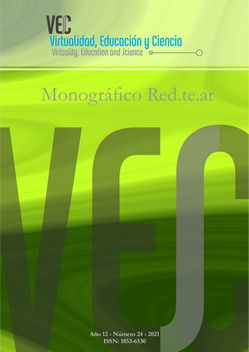Student learning experiences during COVID-19 pandemic. An analysis of synchronous and asynchronous activity in higher education
DOI:
https://doi.org/10.60020/1853-6530.v13.n24.36311Keywords:
higher education; student learning; distance education; synchronous; asynchronousAbstract
This paper investigates students’ experiences during emergency remote teaching caused by the COVID-19 pandemic. The meanings that students give to the virtualization of teaching were explored through the application of a qualitative survey. The mixed analysis of the information facilitated the construction of four dimensions: the configuration of time and space; accessibility through technical resources and technological skills; the relationship between the teaching modality and the proposed learning; and the spaces and modalities of interaction. The results show the need to think about transformations of educational scenarios in terms of a continuum of spaces and times, different and articulated, with proposals that respect the diversity in which the teaching and learning processes take place.
References
BONNÉRY, S. (2007). Comprendre l’échec scolaire. Elèves en difficultés et dispositifs pédagogiques. Lectures, Les livres. Paris: La dispute.
BORTULÉ, V.; SCAGLIOTT, A.; FRISCO, A.; CORVALÁN, D.; CUCH, D. y VIGH, C. (2020). Enseñanza virtual durante la pandemia, un curso de Física elemental. Latin-American Journal of Physics Education, 14(4), pp. 1-8.
BURBULES, N. y CALLISTER, T. (2001). Las promesas de riesgo y los riesgos promisorios de las nuevas tecnologías de la información en educación. En Educación-Riesgos y promesas de las nuevas tecnologías de la información. Madrid: Granica.
CÁZARES SÁNCHEZ, C. (2021). Enseñanza del Derecho en la pandemia. La clase magistral interactiva en la virtualidad. Enfoques jurídicos, (4), pp. 27-38.
DUSSEL, I. (2021). Sincronías y asincronías en las pedagogías de la igualdad. Revista Scholé 2021(06), sección Espacio Conceptual. Repositorio ISEP: Sincronías y asincronías en las pedagogías de la igualdad.
DUSSEL I. Y TRUJILLO REYES, B.F. (2018). ¿Nuevas formas de enseñar y aprender? Las posibilidades en conflicto de las tecnologías digitales en la escuela. Perfiles Educativos, XL, pp. 145-178.
GARCÍA, I. y LÓPEZ, C. (2011). Los recursos de aprendizaje. En B. Gros Salvat (Ed.), Evolución y retos de la educación virtual, pp. 93-144. Barcelona: Editorial UOC.
HODGES, C.; MOORE, S.; LOCKEE, B.; TRUST, T. y BOND, A. (2020). The Difference Between Emergency Remote Teaching and Online Learning. Educause. Disponible en https://er.educause.edu/articles/2020/3/the-difference-between-emergency-remote-teaching-and-online-learning
MAYER, R. y MAYER, R. E. (Eds.). (2005). The Cambridge handbook of multimedia learning. Cambridge: Cambridge University Press.
MIGUEL ROMÁN, J. A. (2020). La educación superior en tiempos de pandemia: una visión desde dentro del proceso formativo. Revista Latinoamericana De Estudios Educativos, 50, pp. 13-40. DOI: https://doi.org/10.48102/rlee.2020.50.ESPECIAL.95.
LÓPEZ-BOTELLO, F.; MENDIETA-RAMÍREZ, A.; ALEJANDRO-GARCÍA, S. (2021). Experiencias y sentires en torno a la pandemia del virus COVID-19, la perspectiva de los estudiantes universitarios. Revista RedCA, [S.l.], 4(10), pp. 147-169. Disponible en https://doi.org/10.36677/redca.v4i10.16631.
MASSCHELEIN, J., y SIMONS, M. (2014). Defensa de la escuela: una cuestión pública. Buenos Aires: Miño y Dávila.
MOREIRO, F. S.; GUASTAVINO MOSNA, M. L.; CASTRO CHANS, B. y ARDUINO, G. A. (2021). La perspectiva de los estudiantes sobre el cursado de una asignatura de primer año en tiempos de pandemia, TEyET, 28, pp. e55. Disponible en https://doi.org/10.24215/18509959.28.e55.
NIN, C.; ACOSTA, M. Y LEDUC, S. (2020). Pandemia en el siglo XXI. Reflexiones de la(s) geografía(s) para su comprensión y enseñanza. Huellas, 24(1), pp. 219-239.
PADILLA, V., VÁZQUEZ GIL, L.; TORRES RUIZ, E. GALLARDO, M. y PELLE, M. (2020). Perspectiva de los estudiantes sobre la virtualidad en la pandemia. Memorias 1er. Congreso de Educación en Ciencias Biológicas. Edición virtual, 27 y 28 de noviembre de 2020. Facultad de Odontología.
PEREYRA, A. (2020). Viejas y nuevas desigualdades educativas. Desafíos emergentes a la formación docente. En I. Dussel, P. Ferrante y D. Pulfer (Comps.). Pensar la educación en tiempos de pandemia. Entre la emergencia, el compromiso y la espera. Buenos Aires: UNIPE Editorial Universitaria.
PÉREZ-LÓPEZ, E.; VÁZQUEZ ATOCHERO, A.; CAMBERO RIVERO, S. (2021). Educación a distancia en tiempos de COVID-19: Análisis desde la perspectiva de los estudiantes universitarios. RIED. Revista Iberoamericana de Educación a Distancia, 24(1), pp. 331-350.
PEREZ ZAMBÓN, S. (2020) Desafíos para una educación post-pandemia. Reseña del evento Virtual Educa Connect “Reset educativo Ecosistemas digitales para el desarrollo humano”. Revista Desvalimiento Psicosocial, 7(2). ISSN electrónico: 2362-6542.
ZIMMERMAN, J. (2020). Coronavirus and the Great Online-Learning Experiment. The Chronicle of Higher Education, March 10. Disponible en https://www.chronicle.com/article/Coronavirusthe-Great/248216
ZSIGMOND, I. (2020). Promoting Gender Equality in Educational Settings: The Role of Computer Supported Cooperative Learning. Uşak Üniversitesi Sosyal Bilimler Dergisi, 8(1), 9-20.
Downloads
Published
Issue
Section
License

This work is licensed under a Creative Commons Attribution-NonCommercial 4.0 International License.
The generation of derivative works is allowed as long as it is not done for commercial purposes. The original work may not be used for commercial purposes.


